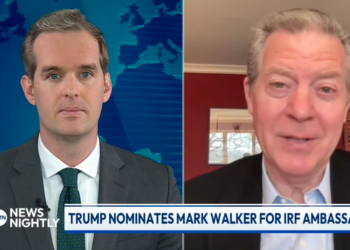This week, like the week before it, can only be described by one word: tumultuous. Stock markets around the world have plummeted, phone calls are being made, messages are being put out on social media, and everyone is trying desperately to make sense of what is happening and what will likely happen. What could possibly have caused this degree of abject panic and confusion?
Trump’s Tariffs.
Specifically, the tariff policies being implemented by the United States against countries from across multiple dimensions. Tariffs against friend and foe? Check. Against rich and poor nations? Check. Inhabited and uninhabited? Shockingly, also check. (RELATED: Tariffs, a Solution in Search of a Problem)
While tariffs themselves are bad enough for economic growth and prosperity, there is something even worse than tariffs lurking in the background right now: uncertain tariffs.
The timeline of events reveals how the back and forth of “Will he, won’t he?”, “Is he going to delay it another 30 days or are these here to stay?”, and “Will he make exemptions or not?” have wreaked havoc on investors, particularly their confidence, and have even started to show up in consumer confidence data. Even the mistaken reporting of Trump announcing a 90-day pause on all tariffs sent markets soaring as investors tried to strike while the iron was hot.
But all of this could, at some level, be forgiven if there was a coherent, concrete, and consistently communicated plan for what these tariffs are supposed to accomplish. Unfortunately, even that has proven to be too much to ask for, creating even further uncertainty in markets. (RELATED: The False Promise of President Trump’s Trade Policies)
Consider that President Trump has called his “Liberation Day” tariffs “reciprocal tariffs” and has repeatedly stated that if other countries lower their tariffs, we’ll lower ours. White House officials report that “more than 50 countries have reached out” in an attempt to negotiate with President Trump on reducing trade barriers.
Notably, even the European Union, which I had previously said was unlikely to come to the table, has done so and offered zero-for-zero tariffs. But this was not enough, with Trump now adding to additional demand that the EU also purchase more energy from the US. So are we reciprocating or not? (RELATED: ‘Liberation Day’ and the Double Standard of EU Policy)
Then you have Peter Navarro claiming that Trump’s tariffs are going to raise $6 trillion over the next ten years, but others close to the administration are saying the goal is to negotiate for lower tariffs around the world. Stephen Miran claims that the goal is to devalue the dollar on the world economic stage. (RELATED: Reshaping the Credit Market and the Global Economy)
Trump officials claim that the tariffs are being deployed to create jobs, but Howard Lutnick says that the jobs that will be brought back are going to be automated and that, instead of creating manufacturing jobs, “The army of millions and millions of human beings screwing in little screws to make iPhones — that kind of thing will come back to the America, it’s going to be automated, and great Americans, the tradecraft of America, is going to fix them, is going to work on them.”
Last year, Scott Bessent said that the “tariff gun will always be loaded and on the table, but rarely discharged,” which obviously is not true anymore. Then, in an interview, when asked if Trump was open to negotiating with other countries, Bessent said, “We’ll see,” and when asked why Canada and Mexico were missing from the list of Liberation Day tariffs, he replied with, “I’m not sure.”
Finally, Howard Lutnick says that tariffs are “here to stay” but Trump himself said, around the same time, that he’s ready to negotiate with affected countries.
The only thing that is certain about all of this is the uncertainty surrounding all of this. What are the tariff rates going to be, and will they be delayed? Which countries are going to pay the tariffs and which countries will not? Are we trying to create jobs, raise revenue, shift global supply chains, or negotiate lower trade barriers with other countries? Is it all the above, or is it none of the above? How will the administration adjudicate between competing and sometimes even mutually exclusive goals?
But as if all of that weren’t enough, Congress has finally decided to weigh in on this, at least a little bit, with the Senate recently voting to revoke Trump’s tariffs on Canada.
This coming less than a month after House Republicans used a procedural measure to declare that “each day for the remainder of the first session of the 119th Congress shall not constitute a calendar day for purposes of section 202 of the National Emergencies Act with respect to a joint resolution terminating a national emergency declared by the President on February 1, 2025.” This sentence seems strange until one realizes that what it effectively does is make it exceedingly difficult for Congress to step in and nullify a national emergency declared by President Trump.
The 119th Congress ends Jan. 3, 2027, which means that until then, if Congress wants to end a declared national emergency and wrest back control given to them by the Constitution, they will almost certainly need the signature of… Donald Trump.
The result of all this uncertainty is clear: a massive sell-off of assets as investors seek to find safer investments less exposed to the whims of the self-proclaimed “Tariff Man.” Many of those could very easily be abroad, muting any of the slightly positive impacts that tariffs might have. (RELATED: Presidents Are Not Economic Magicians)
Tariffs are a rotten deal for the American people. What’s worse, though, are uncertain tariffs, and the more uncertainty there is surrounding tariff policies, the worse the outcomes are for every single American. Regrettably, President Trump and his inner circle seem determined to maximize uncertainty along as many dimensions as they can find. In doing so, they are not picking the “least good” option; they are picking the “most bad” option.
It’s time to end this failed experiment once and for all.
READ MORE from David Hebert:
Tariffs: The Hammer America Keeps Using
Saving Us From Scheming Landlords? Biden DOJ Sues Real Estate Tech Company RealPage




![Jasmine Crockett Justifies Mass Illegal Immigration With Bizarre Argument [WATCH]](https://www.right2024.com/wp-content/uploads/2025/03/1742007023_Jasmine-Crockett-Justifies-Mass-Illegal-Immigration-With-Bizarre-Argument-WATCH-350x250.jpg)


![NYC Tourist Helicopter Falls into Hudson River, Siemens Executive and Family Among Those Killed [WATCH]](https://www.right2024.com/wp-content/uploads/2025/04/NYC-Tourist-Helicopter-Falls-into-Hudson-River-Siemens-Executive-and-350x250.jpg)








